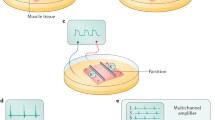Abstract
A FORTRAN program has been elaborated for computerized intestinal Basic Electrical Rhythm (BER) analysis. It is based on recognition of individual cycles limits. The reliability of the method was assessed by comparison between computer and visual cycle limits identification.
The agreement is 98.2% for BER recorded from the frequency plateau. It is 91.4% for fluctuating BER patterns. For BER frequency computing, draw-backs due to misrecognitions were avoided by cancelling sequences in which they occur.
Similar content being viewed by others
References
Basar, E., Eroglu, C.: Spectral analysis of spontaneous activity in smooth muscles. In: Physiology of smooth muscle (E. Bülbring and M. F. Shuba, eds.) New York: Raven Press 1976
Bass, P.: Electrical activity of smooth muscle of the gastrointestinal tract. Gastroenterology49, 391–394 (1965)
Bass, P.: In vivo electrical activity of the small bowell. In: Handbook of Physiology, sec. 6, vol. 4 (C. F. Code, ed.). Washington, D.C.: Am. Physiol. Soc. 1968
Becker, J. C., Wallace, J. N., Nelsen, T. S.: On-line generation of a joint interval histogram from slow rhythmic biological potentials. Med. Biol. Engng.6, 415–423 (1968)
Bendat, J. S., Piersol A. G.: Random data analysis and measurement procedures. New York-London-Sydney-Toronto: John Wiley and Sons, Inc. 1971
Bortoff, A.: Slow potential variation of small intestine. Am. J. Physiol.201, 203–208 (1961)
Bortoff, A.: Myogenic control of Intestinal Motility. Physiol. Rev.56, 418–436 (1976)
Bortoff, A.: Intestinal slow-wave propagation velocity as a function of longitudinal muscle impedance. In: Physiology of smooth muscle (E. Bülbring and M. F. Shuba, eds.) New York: Raven Press 1976
Carlson G. M., Bedi B. S., Code C. F.: Mechanism of propagation of intestinal interdigestive myoelectric complex. Am. J. Physiol.222, 1027–1030 (1972)
Code, C. F., Szurszewski, J. H., Kelly K. H., Smith, I. B.: A concept of control of gastrointestinal motility. In: Handbook of Physiology, sec. 6, vol. 5 (C. F. Code, ed.) Washington, D.C.: Am. Physiol. Soc. 1968
Daniel E. E.: The electrical activity of the alimentary tract. Am. J. Dig. Dis.13, 297–319 (1968)
Diamant, N. E., Bortoff, A.: Nature of the intestinal slow-wave frequency gradient. Am. J. Physiol.216, 301–307 (1969)
Diamant, N. E., Rose, P. K., Davison E. J.: Computer simulation of intestinal slow-wave frequency gradient. Am. J. Physiol.217, 1684–1690 (1970)
El-Sharkawy, T. Y. Daniel, E. E.: The ionic basis of intestinal control potentials. In: Proc. Intern. Symp. Gastrointestinal Motility, 4th (E. E. Daniel, ed.) Vancouver: Mitchell 1974
Farrar, J. T.: Use of a digital computer in the analysis of intestinal motility records. IRE Trans. Med. Electr. Oct., pp. 259–263 (1960)
Hiatt, R. B., Goodman, I., Sandler, B., Cheskin, H.: The effect of coherin on the Basic Electrical Rhythm of the dog ileum in vivo. Am. Dig. Dis.22, 108–112 (1977)
Hiesinger, E., Hornicke, H.: Computer analysis of electrical and mechanical activity of the stomach duodenum and cecum over long periods. In: Gastrointestinal Motility in Health and Disease (H. L. Duthie, ed.) London-New York: M.T.P. 1978
Linkens, D. A.: Methods of analysing rhythmic electrical potentials in the G.I. tract. In: Gastrointestinal motility in health and disease (H. L. Duthie, ed.) London-New York: M.T.P. 1978
Max, J.: Méthodes et techniques de traitement du signal. Paris: Masson 1972
Prosser, C. L., Bortoff, A.: Electrical activity of intestinal muscle under in vitro conditions. In: Handbook of physiology, sec. 6, vol. 4 (C. F. Code, ed.) Washington, D.C.: Am. Physiol. Soc. 1968
Sarna, S. R., Daniel, E. E., Kingma, Y. J.: Simulation of slow-wave electrical activity of small intestine. Am. J. Physiol.221, 166–175 (1971)
Weisbrodt, N. W.: Gastrointestinal motility. In: Gastrointestinal physiology (V. D. Jacobson and L. L. Shanbour, eds.) London-Baltimore: Butterworth 1974
Yonagathan, A. P., Gupta, R., Corcoran, W. H.: Fast Fourier transform in the analysis of biomedical data. Med. Biol. Engng.14, 239–243 (1976)
Author information
Authors and Affiliations
Additional information
Supported by grant no ATP 177540 and no CRL 74.518507 from the INSERM
Rights and permissions
About this article
Cite this article
Pousse, A., Mendel, C., Vial, J.L. et al. Computer program for intestinal basic electrical rhythm patterns analysis. Pflugers Arch. 376, 259–262 (1978). https://doi.org/10.1007/BF00584960
Received:
Issue Date:
DOI: https://doi.org/10.1007/BF00584960



